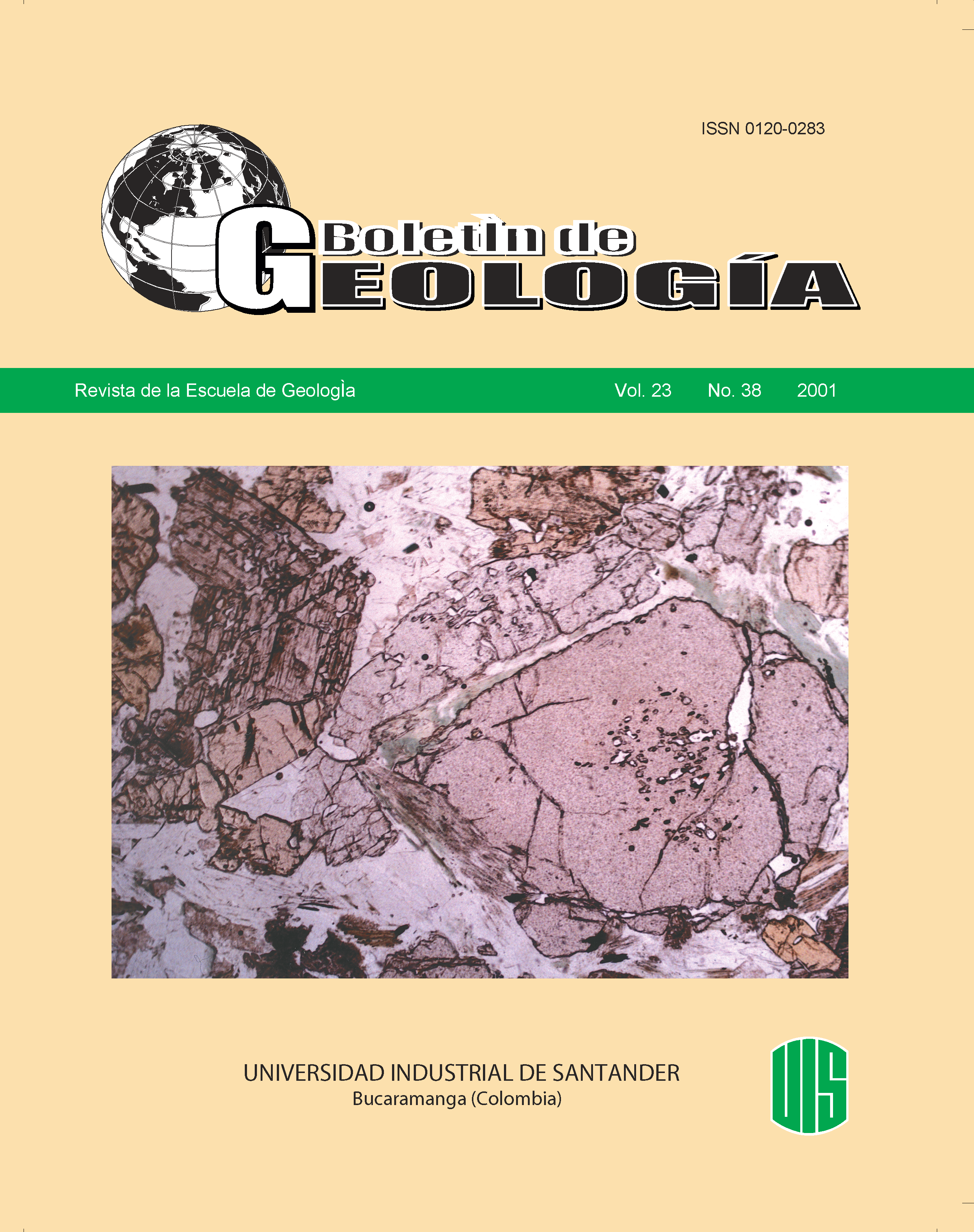Distribución espacial y relación entre organismos fósiles. Breve síntesis paleoecológica de Toxaster colombianus y Thalassinoides
Published 2001-10-02
Keywords
- Space distribution,
- Palaeoecoloy,
- Toxaster colombianus,
- Thalassinoides,
- Rosablanca Formation
- Paleontology ...More
How to Cite
Abstract
In a strata from the upper bioesparudite from the Rosablanca Formation that outcrops by the Zapatoca Bucaramanga road at 1430 meters sea level, a counting of organisms was carried out using a grid of 1 mt2 divided into squares of 20X20 centimeters as sample units. The grid in mention was placed in a 5 meters long transect over the top of the strata. With the obtained data, using the Ludwing statistic package and the paried - quadrant variances method (PQV), it was determined that the spatial distribution patterns of the Toxaster colombianus correspond to an uniform model. Initially, a hypothesis was presented suggesting the existence of an assembly between the T. colombianus and the Thalassinoides. But applying a contingency frame of 2X2, it was proved that there was no such assembly between these two organisms. On the contrary, the value of intensity index suggests some sort of negative interaction between them.
Downloads
References
Barnes, R. D. (1989). Zoología de los Invertebrados.Interamericana. México. p.957
Brusca, R., Brusca, G. (1990). Invertebrates. SinauerAssociates, Inc. USA. p.922
Clark, W. B. (1893). The Mesozoic Echinodermata ofthe United States. US Geol. Surv. Bull. 97, pp.1-2073
Cooke, C. W. (1955). Some Cretaceous Echinoidsfrom the Americas. Geol. Surv. Prof. Pap. 264 -E,pp.83-112
Cruz Guevara L. E., Jerez Jaimes J. H., Narvaez ParraE. X., y Franco Blanco R. A.(2000) Análisis devariables morfométricas de Toxaster roulini Agassiz(echinoides : toxasteriidae) de la formaciónRosablanca, Municipio de Zapatoca (Santander,Colombia). Boletín de Geología, Univ. Ind. Sant. Vol.22, N° 37, pp.7 - 17
Etayo, S. F. (1964). Posición de las faunas en losdepósitos cretácicos colombianos y su valor en lasubdivisión cronológica de los mismos. Boletín deGeología, Univ. Ind. Sant. Números 16-17. pp.5-142
Guzmán O. G. (1985). Los gliféridos infracretácicosAetostreon couloni y Ceratostreon boussingaulti, dela Formación Rosablanca, como indicadores deoscilaciones marinas. En Etayo, S. F. y otros. ProyectoCretácico, contribuciones. Publicaciones especiales delIngeominas. N° 16, capítulo XII. pp.1 - 14
Krebs, C. J. (1985). Ecología. Estudio de ladistribución y la abundancia. Harla. México. p.753.
Nèraudeau, D. y Mathey, B. (2000). Biogeographyand diversity of South Atlantic Cretaceous echinoids:implications for circulation patterns. Palaeogeogr.Palaeoclimatol. Palaeoecol. 156, pp. 71-88
Raup, D y Stanley, S. (1978). Principios depaleontología. Editorial Ariel. p. 456
Rhoads, D. C. (1967). Biogenic reworking ofintertidal and subtidal sediments in Barnstable Harborand Buzzards Bay, Massachusetts, Jour. Geol. No 75.Pp. 461-476
Seilacher, A. (1964). Biogenic sedimentarystructures, en J. Imbrie y N. D. Newell, Eds:Approaches to paleoecology, Wiley, New York. pp296-316
Smiser, J.S. (1936). Cretaceous Echinoids fromTrans-Pecos Texas. J. Paleontol. 10, pp.449-480
Telford, M; Mooi, R. y Ellers, O. (1985). A newmodel of podial deposit feeding in the sand dollar,Mellita quinquiesperforata: The sieve hypothesischallenged. Biol. Bull., 69: pp.431-448. Dispersiónde T. colombianus
